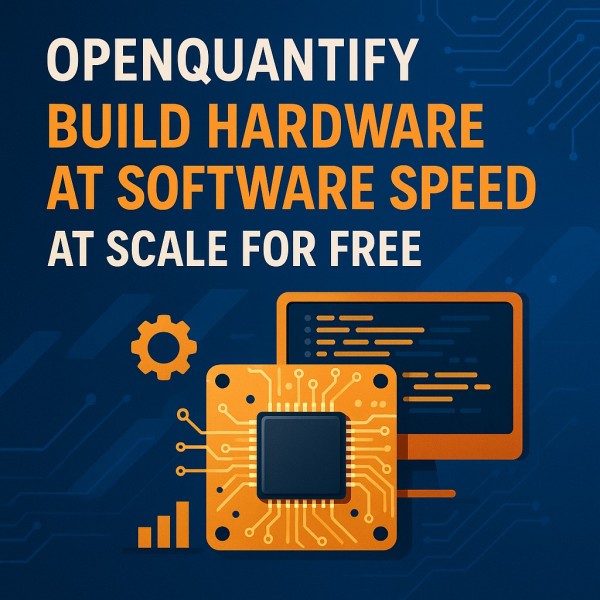Paul George Savluc Announces Global Engineering Program to Accelerate Robotics AI and Digital-Twin Development Across Industries

OpenQQuantify launches a cross-border initiative connecting engineers, universities, and enterprises to accelerate generative hardware design through agentic AI and physics-based digital-twin simulation, enabling faster and safer development of electronics, robotics, and embedded systems worldwide.
North Vancouver, BC, Canada, 17th Oct 2025 — Paul George Savluc built OpenQQuantify, a digital-engineering platform specializing in generative AI and physics-based simulation for electronics and robotics, has announced a multi-month program designed to accelerate global collaboration in embedded systems development. The initiative introduces a unified environment where engineers can design, simulate, and validate hardware systems before physical prototyping.

Book a meeting with Paul George Savluc to help you on any project here: https://calendly.com/openqquantifyexecutivemeeting/businessdevelopment
The program includes seasonal milestones running from October through December 2025 and extends into early 2026. It focuses on accelerating real-world product validation through agentic AI co-engineering, digital-twin environments, and supply-chain intelligence. The initiative supports companies, researchers, and educators who seek to reduce hardware costs, improve reliability, and shorten development cycles.
“Engineering is entering a phase where physical prototypes no longer need to come first,” said Paul George Savluc, Founder and Chief Executive Officer of OpenQQuantify. “By integrating simulation, AI-generated firmware, and real-time procurement data, organizations can design responsibly, validate early, and deliver products with greater efficiency and transparency.”
The platform provides a secure framework for hardware and software integration across multiple device families, including embedded boards such as Nvidia Jetson, Raspberry Pi, ESP32, Arduino, BeagleBone, and RISC-V. Engineers can use OpenQQuantify’s AI-driven tools to generate firmware, model sensors and actuators, and preview device performance inside realistic digital environments.
Program Phases and Capabilities
October – Development Phase:
Participants focus on converting ideas into validated digital prototypes. The platform’s AI agents assist in writing firmware, generating wiring diagrams, and verifying performance metrics such as timing, power, and memory usage.
November – Scaling and Integration:
The program expands to include pilot projects in industrial IoT and robotics. Organizations can benchmark predictive-maintenance systems, vision-based inspection, and mobility control within simulated environments. Supply-chain intelligence tools evaluate bills of materials, identify cost-effective substitutes, and analyze lifecycle risks.
December – Demonstration and Collaboration:
A global hackathon and demonstration series highlight the use of digital twins for smart devices, automation, and educational projects. Selected teams will showcase simulation-based workflows that replace costly physical iterations.
Core Platform Functions
- Agentic AI Co-Engineers: Task-aware agents that generate and test embedded code, ensuring compliance with hardware constraints and documentation standards.
- Physics-Aware Digital Twins: Simulation models that replicate sensor dynamics, latency, and fault behavior to strengthen product reliability before fabrication.
- Procurement Intelligence: Real-time analytics ranking component alternatives by cost, availability, and sustainability to help procurement and compliance teams plan production schedules.
- Security and Compliance Patterns: Frameworks for secure boot, firmware signing, and long-term cryptographic resilience, aligned with industry and academic best practices.
- Education Mode: A guided learning environment that transforms engineering prototypes into interactive lessons for classrooms, technical programs, and workforce training.
Measured Outcomes
Early deployments indicate measurable efficiency gains:
- Cost avoidance during initial prototyping stages through simulation-first validation.
- Cycle-time reduction from multi-month iterations to a few weeks using automated code generation and testing.
- Improved cross-team collaboration via visual digital-twin models accessible to technical and non-technical stakeholders alike.
“Visualizing a functioning device in simulation before fabrication changes how teams plan, budget, and communicate,” Savluc added. “It allows every stakeholder—from engineering to procurement—to make decisions based on tested, visible behavior.”
Applications
The initiative supports startups validating early prototypes, enterprises modernizing industrial automation, and universities training students in embedded systems and robotics. Sectors already engaged in the program include manufacturing, logistics, smart-building management, agriculture technology, and medical instrumentation.
OpenQQuantify’s integrated workflow aligns hardware design with data-driven sourcing, helping organizations meet 2025–2026 production goals without the typical delays caused by supply-chain volatility. The company’s simulation-based approach also strengthens sustainability efforts by reducing material waste and minimizing failed physical iterations.
About OpenQQuantify
OpenQQuantify is a technology company that develops generative hardware and intelligent digital-twin software for engineering and research applications. Its platform unites artificial intelligence, simulation, and supply-chain analytics to enable safe and efficient design of electronics, robotics, and industrial systems. Headquartered in Washington, D.C., with operations in Vancouver, British Columbia, and Bucharest, Romania, the company collaborates with global partners across academia and industry to advance accessible engineering innovation.
Website: www.openqquantify.com
Company Details
Organization: OpenQQuantify
Contact Person: Paul Savluc
Website: https://www.openqquantify.com
Email: Send Email
Contact Number: +40751476842
Address: 560 Raven Woods Drive, suite 215
Address 2: suite 215
City: North Vancouver
State: BC
Country: Canada
Release Id: 17102534899
